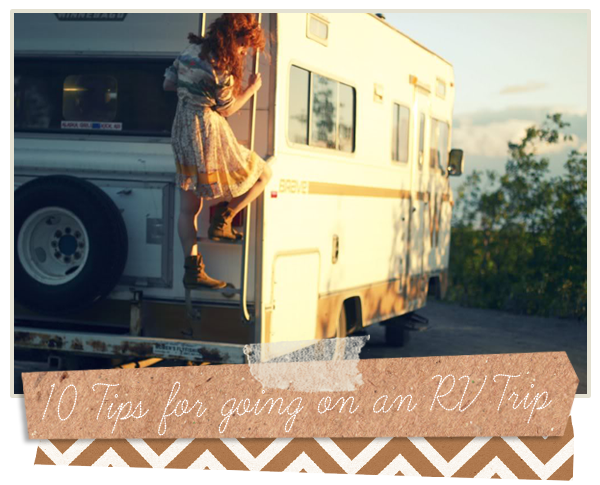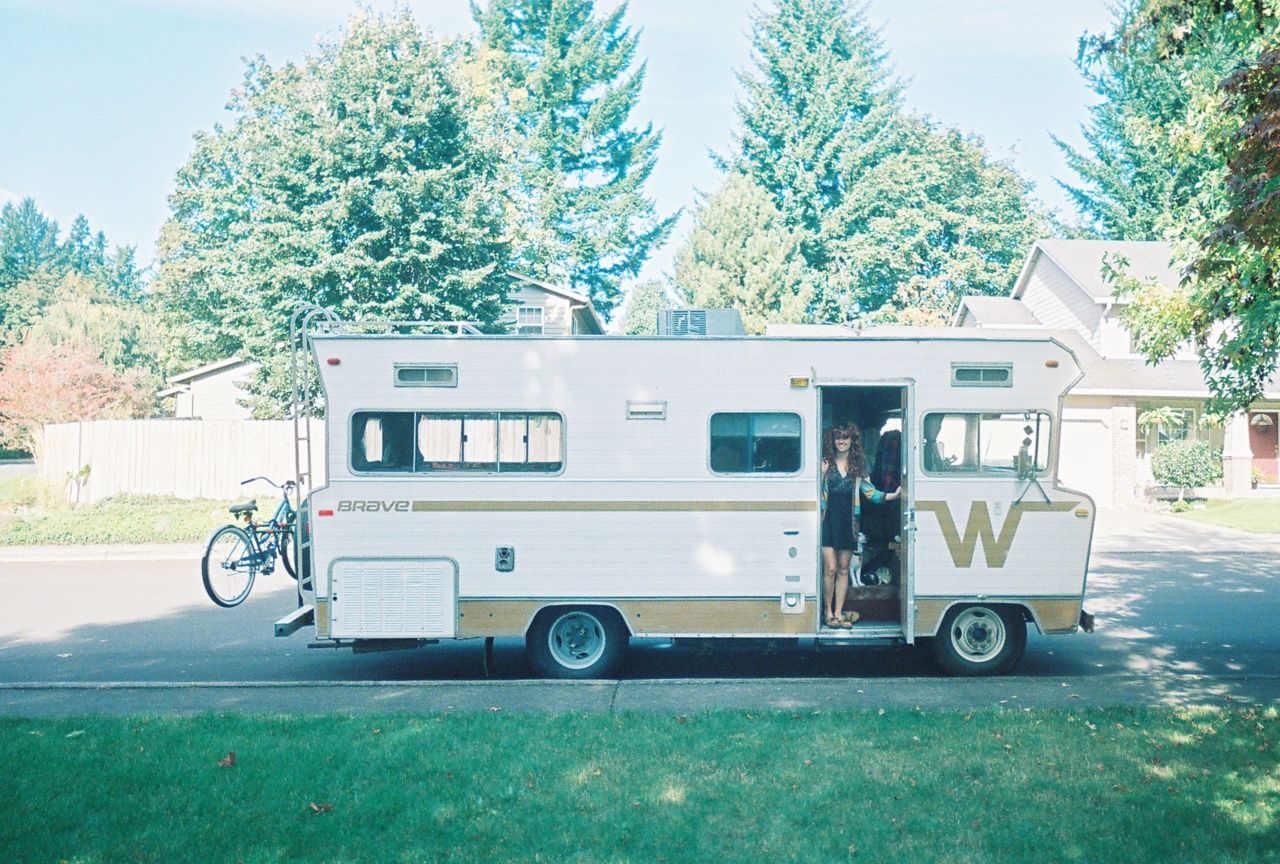
1. Carefully research the RV you want.
This is important. Choosing the RV you want to travel around in, especially if it's going to be long term, is vital. You want to make sure the layout works for you and there's enough storage space for the people traveling (especially if you're not going it alone, like I did). You need to decide if you want a newer RV or a more vintage one.
You also have to determine what size RV you want, and also what size you feel comfortable driving. The Brave was quite small, a 20 ft Winnebago, but I'd driven my parents' 35 ft RV with a tow vehicle behind it, so I knew that I'd be fine driving the 20 footer. But if you aren't comfortable driving a larger vehicle, either get something smaller, or spend the time training yourself to learn how to drive a larger RV.
If you're getting an older model, figure out how much you're willing to spend to fix it up. Sometimes you can find older RVs in good condition, but sometimes they're definitely fixer-uppers. What can you fix yourself? Do you have resources available that you can use to fix it yourself, or will you have to take it to a shop to fix things? Buying an older RV can sound romantic, but once you have a lemon sitting in your driveway, you'll quickly fall out of love and into debt.
2. Save money & budget.
If you want to go on a trip, especially a long term trip, you'll need to save money. I worked a full time job for about 9 months and was living at home (rent free, thankfully) so I was able to save quite a bit before leaving on my trip. You don't want to be in the middle of nowhere with an empty tank of gas because you didn't budget. Know the gas mileage you'll get and figure out how far you want to travel. By estimating the price of gasoline, you can pretty much figure out how far you can go on the amount of money you get. Know that RVs don't get very good gas milage. In my experience, it's from 7-14 miles per gallon. Yep, pretty bad, but you're driving your entire house around. My 1973 Winne got about 7 MPG, 9 on a good day and it ran on Unleaded Gasoline. My parents RV was a 2007 35 ft. Four Winds that ran on Diesel and it got 14 MPG at the most. It's a fact of life, these gals are thirsty.
If you're really into being more green and saving money, you can look into converting your RV to run on Veggie oil. I'm pretty sure this is more feasible if you have a Diesel engine. I never looked into it because I wanted the security of knowing I could find fuel when I needed it. I was traveling from Alaska down the AlCan, where gas stations are hard to find, much less somewhere that had large stores of vegetable oil, so it wasn't a good idea for me, but for someone else, it's might be a great solution. Remember that you'd have to factor in the cost of the conversion, also.
Also, decide how you're going to camp. Campgrounds run between $20 and $40/night, typically. State Parks can be cheaper, and there are some places you can stay for free or boondock. Since I was a girl traveling alone, I decided it was safer to stay in campgrounds, as there was always a campground host. Plus, most campgrounds have water/electric/sewer hookups, and many also have free wifi, which was nice for blogging on the road.

3. Once you find a viable option for sale, inspect it carefully.
Like I said earlier, you don't want to get all excited, buy one and then realize it's got thousands of dollars of repair work that you didn't budget for. If you don't know enough about cars, RVs, engines, etc, take someone with you who does and can figure out if it's a good deal.
Look at the roof, is it leaky? If you're walking on the roof and there are parts that sag, it's likely there's water damage. Look at the seals around the roof, this is often an area where water damage can occur. You can also look inside to see if there's any evidence of water damage. Water damage can totally destroy a roof, which can cost a ton of money to fix.
Check out the engine and transmission, are they in good running order? Ask to take a test drive to see how it runs (always do this). See how well it reacts when you turn the steering wheel and get a feeling for how it feels to drive it. Do you feel comfortable driving it? Do the running lights work? Turn signals? Headlights? Brakes? This is all mechanical stuff. Now go inside to the living area.
Check out the living arrangement. Are there enough beds for you and anyone who will come with you? Luckily RV's are usually pretty sly when it comes to bed placement. My 20 ft Winnebago can probably sleep at least 5, and my parents' RV slept all 5 of our family members on a 2.5 month RV trip, no problem.
Now figure out if things work. Fridge? Heater? Air Conditioner? Water Pump? Septic? Propane? Remember, if any of these things are broken, it'll cost you money to fix, unless you have the parts and know-how to do it yourself. All this should factor into your decision.
4. Where do you want to go?
You have to figure out where you want to go! On my trip I decided I wanted to go down the west coast and across the southern states to the Atlantic. I had already road tripped across the northern and east coast states with my family in 2007 and had never been to the south, so I chose that route. I also was traveling in the middle of autumn and winter, so I wanted to be driving in places with warmer climates. Do you have any places you're dying to visit? Make sure to hit them on your trip!

5. Join travel clubs.
Joining clubs like Good Sam, AAA, KOA can save you money and can come in handy if you find yourself in a bind. The savings you'll get from joining clubs like these can really add up if you plan on being on the road for a long time.
AAA can give roadside assistance, which can be a lifesaver. They can help you with flat tires, lockouts, towing, gas, jump starts, etc. AAA membership can get you discounts at a lot of places too, including some campgrounds and places like Jiffy Lube and NAPA auto parts.
Good Sam Club gives a 10% discount on over 1,700 Good Sam approved campgrounds. You can also save money at various RV parts stores, service centers, and more.
By joining KOA's membership club, you get discounted rates when you stay at KOA campgrounds. If you plan on staying at KOAs, this is a great membership to have. KOA campgrounds are nice because you can pretty much guarantee that you'll have W/S/E hookups, wifi, laundry, and a bathroom with showers. A lot of KOAs have fun activities too and good shops where you can even sometimes rent DVDs (I did this when I stayed at the KOA in Sacramento!). They're also almost always really close to highway exits, so you typically don't have to drive your huge rig down tiny backroads to find them. As much as I loved finding quirky campgrounds in random places, pulling into a KOA was always like a breath of fresh air. I always felt safe and was glad to know that I could take a nice hot shower and get my laundry done.
6. Compile maps and navigation aids.
Nowadays an iPhone is pretty much all you need, but it's a good idea to have physical maps as well. AAA gives out free maps to their members, which is pretty cool! If you plan on traveling through places where you don't have cell service for an iPhone's map app to work, having maps is absolutely necessary. You can also invest in a GPS system, if you want to drop the cash to get one. I don't see a need for one if you know how to read a map, or if you have a smart phone. If you don't have a good sense of direction and have trouble navigating, however, it could be a good investment.

7. Woodalls.
Woodalls is a really great resource for finding campgrounds. Woodalls has a pretty comprehensive list of campgrounds organized by state and town, and they also have an iPhone app! They rate every campground and give information about the amenities available.
8. Mobile Internet.
If you want to keep blogging consistently on the road (if you're a blogger like me), or if you just want to stay connected, you might want to consider getting a mobile internet hotspot card or USB port. I got a USB lightning port through AT&T which I used on my trip. I think it was about $70-80 per month and I believe it was 5GB. I ended up using up my limit pretty much every month because I was uploading so many photos for my blog, but if you aren't blogging heavily like I was, it should be fine. One of my friends has a Verizon mobile hotspot, which seems like a pretty cool way to access internet on the road too.

9. Alternative Transportation: Tow vehicle and bikes.
How do you want to get around, other than RVing? Once you're all settled into your campground, with your RV hooked up and plugged in, you won't want to unplug it just to go to the grocery store or sightseeing. A great option is to pull a tow vehicle. This is great for family situations and is really the best way to see national parks and other sites. A lot of parks have winding roads and tight squeezes, not exactly fun driving in an RV (plus the gas can get expensive with all that zipping around). My family towed our Honda CRV when we went on our trip on '07 and it was a great way to do things.
Another option is to haul bikes. I took a bike with me on my trip in 2010 and used it to ride around to restaurants and grocery stores. Unless your a pro cyclist, it's probably not super effective to use a bike to get around national parks, simply due to their vast size.
10. iPhone apps.
While I don't find that I need an iPhone in my daily life, it was an invaluable asset on my trip. The GPS map app is wonderful and there are a ton of apps crafted with the RVer in mind that are perfect for traveling. Here are some great apps for iPhone:
RV Dumps- find the nearest dump station for your septic
Gas Buddy- to find the cheapest gas in the area
iHandy Level - to make sure your RV is level when you're camped





![This print feels even more relevant today. We all joke about the dumpster fire of [insert year here], but the important message of this image to me is that *we persist* through the horrors. We stand, we fight— maybe for ourselves, maybe for oth](https://images.squarespace-cdn.com/content/v1/574dddd6d51cd4bc35c1609a/1730935170369-03GPKQ5NF73VAE65RHO6/image-asset.jpeg)


